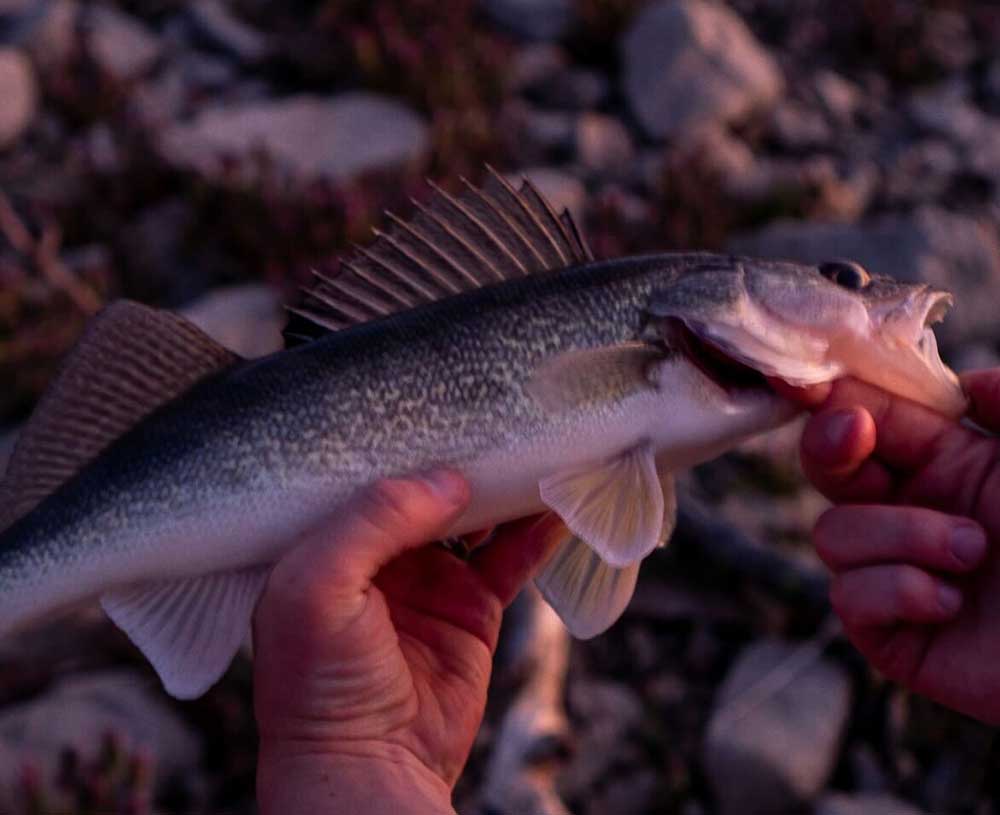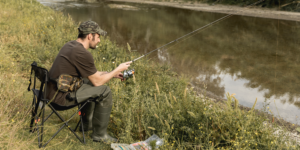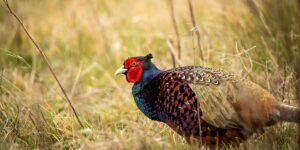Embarking on a night fishing expedition for walleye can lead to a thrilling experience.Few things compare to the excitement of landing a big walleye under the cloak of darkness. As moonlight pierces the water’s surface, night becomes a stage for the predatory walleye, transforming the lake into a dynamic ecosystem. This article will guide you through the intricacies of night fishing for walleye, providing insights, techniques, and tips to boost your success during nocturnal fishing trips.
Why limit yourself to public land when there are millions of acres of private land to explore.
The Walleye – King of Night Fishing
Walleye, with their marble-like eyes reflecting the moonlight, are a favorite target for many night anglers. Their excellent night vision allows them to navigate and hunt efficiently in the dark, giving them an edge over their prey. During the daylight hours, walleyes spend their time lurking in the deep water, conserving energy and avoiding the sun’s harsh rays. As the daylight wanes and the aquatic world immerses into twilight, walleyes begin their nightly migration to shallower water in search of prey.
Their movement patterns and predatory behavior make walleye fishing at night a unique and rewarding experience. The prospect of catching a big walleye, the aquatic equivalent of a trophy buck, lures many anglers to the lake after sunset.
Understanding Walleye Behavior
Before delving into the techniques and strategies for night fishing, it’s important to understand the behavior of walleye. Walleye are a species of fish that have evolved to thrive in various conditions, and one of their most notable characteristics is their adaptability to different light conditions. Walleye have unique, photosensitive eyes, which give them a significant edge in the darker hours. These fish are essentially nocturnal and become more active as the light fades.
At night, walleye move from their daytime deep-water retreats to shallower waters to hunt. This nocturnal movement often brings walleye closer to the shore, making the shoreline, fishing pier, or a shallow water boat an excellent place to be when the sun goes down. The nocturnal habits of the walleye provide anglers with opportunities to catch these elusive fish after sunset and into the night.
The Advantages of Night Fishing for Walleye
One of the most appealing advantages of walleye fishing at night is the reduced fishing pressure. As most anglers retreat at sunset, the waters become less crowded, allowing you to enjoy a serene and undisturbed fishing experience.
Another advantage of night fishing lies in the behavior of the walleyes themselves. As nocturnal predators, walleyes become more active and aggressive during the night, increasing the chances of a successful catch. Understanding and leveraging the moon phases can play a crucial role in this aspect.
During a full moon, the increased light levels can lead to heightened activity among walleyes. Similarly, the cover of a new moon can also trigger increased feeding as the lower light conditions provide walleyes with an added advantage over their prey. It is during these times, under the glow of a full moon or the cover of a new moon, that walleyes often venture into extremely shallow areas in pursuit of baitfish.
Gear Up for Night Walleye Fishing
Preparing for a night fishing expedition requires careful selection and organization of your fishing gear. Simplifying your gear is key to avoiding unnecessary complications in low light conditions. Your fishing rods should be reliable and suited to the type of fishing you plan to do, whether that’s casting or trolling.
Lighted slip bobbers are an excellent addition to your gear, providing visual cues of a bite in the dark. Similarly, boat lights can improve safety and functionality by illuminating your workspace. Remember to pack extra batteries for essential electronics like your cell phone and boat lights.
When fishing at night, it can be beneficial to use lighted floats or glow sticks attached to your line to help you visualize your line movement and detect bites more easily. Moreover, a good fishing headlamp can also make tasks like baiting hooks and unhooking fish much easier.
Retrieving your gear at night can be tricky, especially if you have multiple lines in the water. To avoid entanglement, it can be helpful to use different rod lengths for each line and space them out appropriately.
Techniques and Tactics to Catch Walleye at Night

There is a multitude of techniques and tactics that you can employ to catch walleye at night. The key to success lies in understanding their behavior and adapting your strategies accordingly.
One of the most effective techniques for night fishing is trolling, especially in deeper water. Trolling allows you to cover as much water as possible, increasing your chances of locating a school of walleyes. Planer boards can be useful in spreading out your lines and covering a wider swath of water.
Vertical jigging can also be successful, particularly in areas where walleyes are known to congregate. This tactic involves dropping your lure or bait vertically down to the depth where the fish are located and then enticing them by moving the bait in an up and down motion.
When fishing in shallow water, casting can yield great results. You can cast your lure near weed beds or structures where walleyes might be hiding and waiting to ambush prey.
Remember to adjust your fishing tactics to the conditions of the night. On a moonlit night, walleyes might be found in shallower water, while on a darker night, they might be found a bit deeper.
Choosing the right bait is crucial when fishing for walleye. Walleye primarily feed on smaller baitfish, making live minnows or minnow-imitating crankbaits a great choice for your lure. In addition, walleye have a keen sense of smell and taste, so lures that are scented or flavored can often attract more bites.
Choosing the Right Bait
Jigs tipped with minnows or nightcrawlers can be particularly effective when fishing in deeper waters. The natural movement and scent of these baits can be irresistible to walleye. Alternatively, you can use shallow-running crankbaits for casting or trolling. These lures mimic the swimming action of baitfish and can be used to cover a larger area, helping you locate fish more quickly.
The hassle free way to monetize your acreage.
Key States for Walleye Anglers
While walleye can be found across numerous states in the U.S., some regions are especially known for their abundant walleye populations. States such as Minnesota, Wisconsin, Michigan, Ohio, and Pennsylvania have numerous lakes and rivers that are excellent for walleye fishing. Research the local regulations for fishing in these areas as they may have specific rules regarding the permissible fishing methods, bag limits, and size restrictions.
Safety Considerations for Night Fishing Trips
While night fishing can be an exciting adventure, it also demands an elevated level of safety awareness. Before setting out on your trip, ensure the lower unit of your boat is in good working condition to avoid mechanical failures on the water. A fully charged cell phone is essential for emergencies, and a backup power bank is a prudent addition.
Understanding the water clarity and the layout of your chosen lake is also vital. Use a depth finder to avoid underwater hazards and to locate potential fishing spots.
Moreover, the use of reflective clothing or a lighted cap can help you stay visible to other boaters. Always inform someone of your fishing location and estimated return time before heading out.
Conclusion
Night fishing for walleye offers a unique blend of tranquility and thrill. With the right gear, effective techniques, and adequate safety precautions, you can enjoy a successful fishing excursion under the moonlight.
Remember, the joy of fishing lies not just in the catch, but in the experience of being one with nature, in the quiet conversations with fellow anglers, and in the stories that you bring back with the sunrise. As the saying goes, a bad day of fishing is still better than a good day at the office.
Why limit yourself to public land when there are millions of acres of private land to explore.
How do you fish walleye at night?
Fishing for walleye at night involves understanding their behavioral patterns and using appropriate techniques such as trolling, casting, or jigging. Using the right bait, such as minnow-imitating crankbaits, and fishing at the right depths can increase your success.
What colors do walleye see at night?
Walleye are known for their exceptional night vision. They can see well in low light conditions and are particularly sensitive to the colors green and blue. However, in dark or murky water, lure vibration and movement can be more important than color.
What color lures for night walleye?
During the night, using lures that contrast with the water color can be effective. Dark colors such as black, blue, or purple can create a silhouette against the lighter sky and attract walleyes. However, under the full moon or in clear water, brighter colors or metallic finishes can also be successful.
How shallow do walleye go at night?
Walleye can go surprisingly shallow at night, often venturing into water less than three feet deep in search of prey. This is particularly true during the full moon and new moon phases, when walleyes are more active and hunting aggressively.
Useful Night Fishing Tips
-Find your fishing spot during daylight to navigate waters easily.
-Bring only the essential gear to avoid clutter and noise.
-Use baits and lures that mimic the walleye’s natural prey, like minnow-imitating crankbaits.
-Stay quiet and stealthy to avoid startling the fish.
-Understand the impact of moon phases on walleye activity levels.
-Cast your line at different angles to cover more water.
-Always prioritize safety: equip your boat with lights, wear a personal floatation device, and keep a reliable light source at hand.


